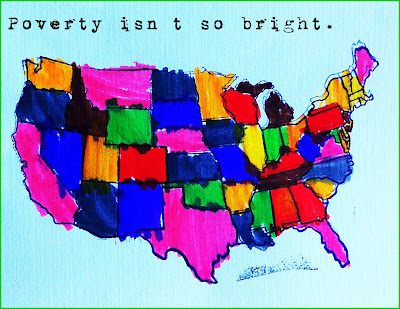 |
| (Thanks, little O, for making the US seem brighter.) |
- The current poverty threshold for a family of two adults and two children is a touch over $22,000 according to the US Census Bureau.
- From the same report, Blacks and Hispanic families experience higher rates of poverty compared to White and Asian/Pacific Islander families - almost 2:1.
- Guess which age group experiences the most poverty? Sadly, our children, ages 18 and younger.
- According to a recent 60 minutes episode (see video below) and other sources, the US is reporting the most homeless children since the Great Depression. How many of your students live in homeless shelters or short-term housing like motels? How does homelessness affect teaching and learning?
- Did you know some writers are calling the current generation of students the "Motel Generation" because of the increased level of homeless/houselessness?
- 20.5 million school-aged students qualify for FARMs (Free and Reduced Meals), which is a cheerless 42.9% of our school-aged population (according to the National Center for Educational Statistics).
- Which areas report the highest number of students who are in need of FARMS? Washington, DC, Mississippi, and Louisiana. With regret, all states have a portion of kids who qualify for FARMs. Maryland has 33.5% of its school-aged population, California has 52% and the-land-of-my-soul, Colorado, 34.8% - Leave no state behind, it seems.....
- The "new" poor of the 21st century is not limited to just kids. The elderly, working families and married-couple families comprise the new poor of this century. And yes, I did say "working" families. Evidently, the current minimum wage of $7.25 isn't cutting it. By the way, I just did the math for two working adults who work 40 hours a week at minimum wage (and deducted 1/3 for taxes). Their weekly income (after taxes) would be $191/adult. That translates to $19,864 a year for a family with two working adults - this is below the poverty threshold as reported in bullet #1. No wonder some high school students drop out of school to gain full-time employment.
- Poverty has socio-emotional effects. Many students report feeling "embarrassed" about their lack of food, clothing, and shelter. Some students also believe it is their fault their family is in poverty (e.g.: "I am one more mouth to feed...."). Students report studying by flashlight (when the electricity is turned off) or sleeping in their family's car when a motel is too expensive. For educators, how does a student's socio-emotional state affect teaching and learning?
- If you know Abraham Maslow's work and his Hierarchy of Needs, right now you are thinking, "Oh no! I've got students with considerable foundational needs." And yes, I just linked to Wikipedia for Maslow's work. If you look at the hierarchy below, you can see how the first two foundational levels, at a minimum, are affected by poverty.
How can we help our students from poverty? Next week on Wednesday, March 23rd, we will tackle some ideas to consider. Be thinking of your own ideas and we can share them that day.
Armed with creativity and hope,
Jen
PS - For those of you who appreciate statistics and data, the US Census Bureau's collection of data and stats is brimming. Click here to see their tremendous collection of reports.
PSS - For those of you who feel a call-to-action now, a friend just shared this foundation's mission with me. If you are in the mid-Atlantic region and have furniture or time to spare, you could make a difference. Visit A Wider Circle. Of course, monetary donations are always accepted.


